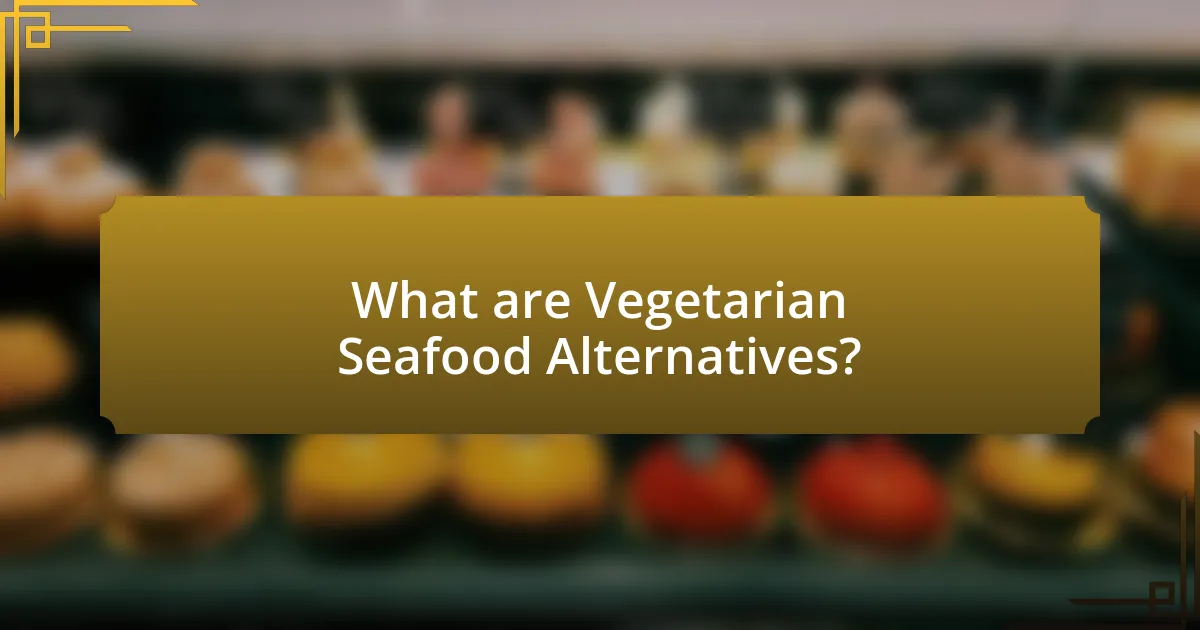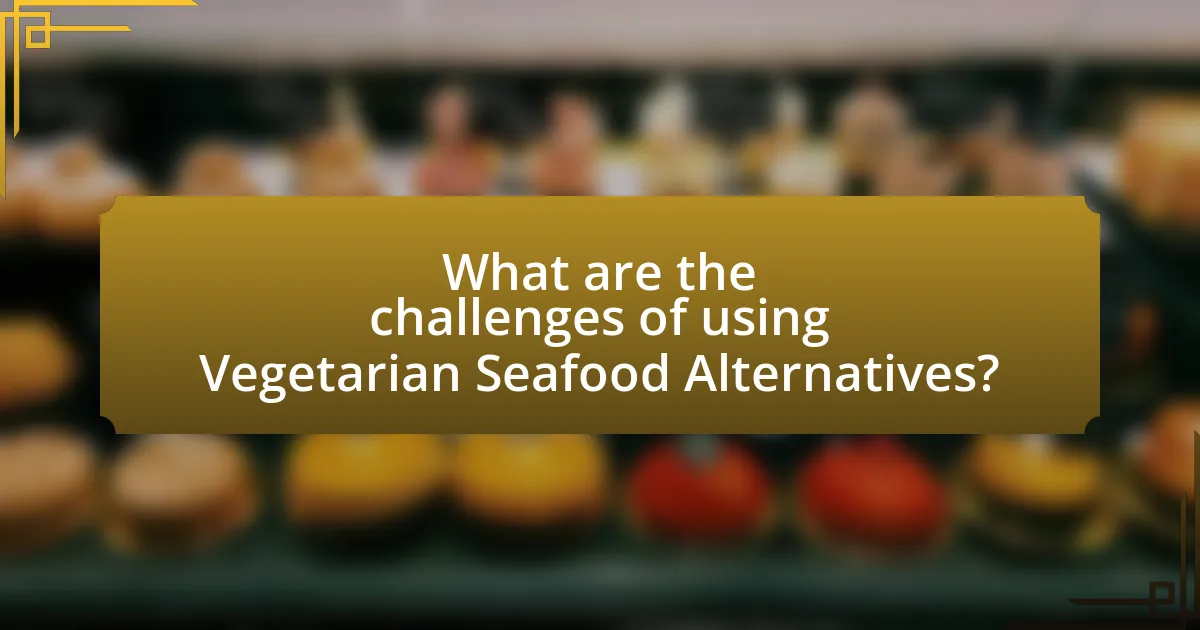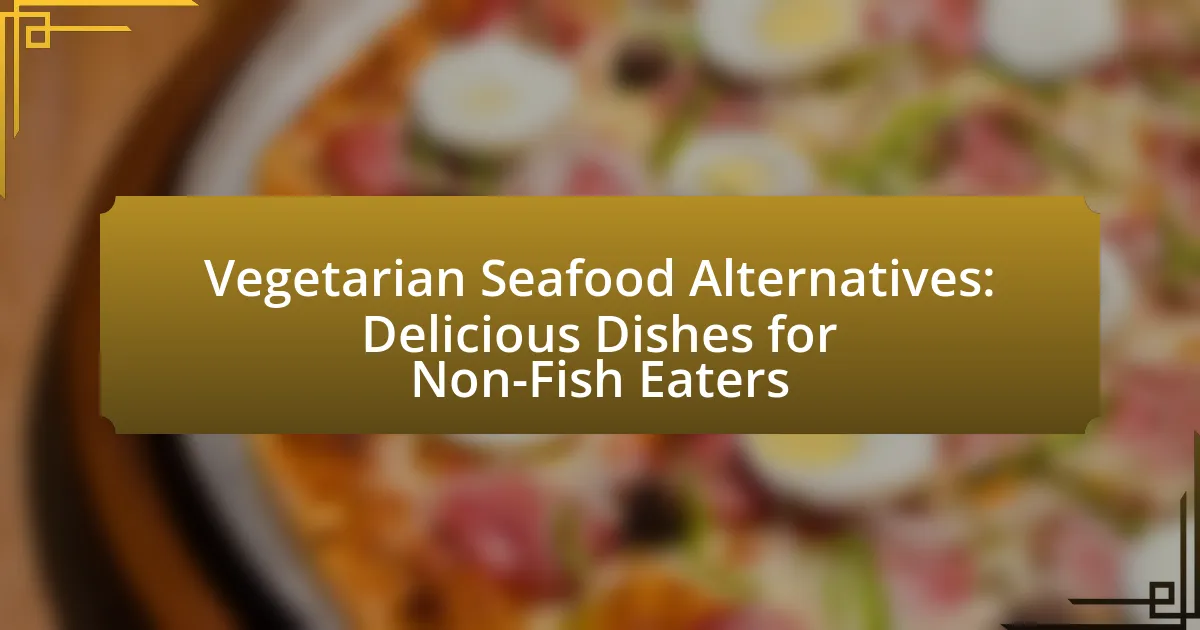Vegetarian seafood alternatives are plant-based products designed to replicate the taste and texture of traditional seafood, utilizing ingredients such as seaweed, tofu, and legumes. These alternatives are gaining popularity due to increasing consumer awareness of health, environmental sustainability, and ethical concerns related to fishing practices. The article explores how these products mimic seafood, the common ingredients used, their health benefits, and their environmental impact. Additionally, it addresses the challenges and misconceptions surrounding vegetarian seafood alternatives, providing insights into their preparation, nutritional adequacy, and incorporation into a balanced diet.

What are Vegetarian Seafood Alternatives?
Vegetarian seafood alternatives are plant-based products designed to mimic the taste and texture of seafood. These alternatives often utilize ingredients such as seaweed, tofu, tempeh, and various plant proteins to create dishes that resemble fish and shellfish. For example, products like algae-based fish fillets and crab cakes made from jackfruit or chickpeas provide a similar culinary experience to traditional seafood while being entirely vegetarian. The growing demand for these alternatives is supported by a 2021 report from the Plant Based Foods Association, which noted a significant increase in sales of plant-based seafood products, indicating a shift in consumer preferences towards sustainable and ethical eating options.
How do Vegetarian Seafood Alternatives mimic traditional seafood?
Vegetarian seafood alternatives mimic traditional seafood primarily through the use of plant-based ingredients that replicate the texture, flavor, and appearance of fish and shellfish. These alternatives often utilize ingredients such as seaweed, tofu, and legumes, which provide a similar mouthfeel and nutritional profile. For example, seaweed can impart a briny taste reminiscent of ocean flavors, while textured vegetable protein can mimic the flaky texture of fish. Additionally, flavoring agents like spices and natural extracts are employed to enhance the seafood-like taste. Research indicates that these alternatives can effectively satisfy the sensory expectations of consumers, making them a viable substitute for traditional seafood in various culinary applications.
What ingredients are commonly used in Vegetarian Seafood Alternatives?
Common ingredients used in Vegetarian Seafood Alternatives include seaweed, tofu, jackfruit, and plant-based proteins. Seaweed provides a marine flavor and is rich in nutrients, while tofu serves as a versatile base that can mimic the texture of fish. Jackfruit is often used for its fibrous texture, resembling shredded seafood, and plant-based proteins, such as pea protein or soy protein, are utilized to enhance the nutritional profile and texture of these alternatives. These ingredients collectively create a satisfying and flavorful experience for those seeking non-fish options.
How do these ingredients contribute to flavor and texture?
Vegetarian seafood alternatives utilize ingredients like seaweed, tofu, and legumes to enhance flavor and texture. Seaweed provides a briny, ocean-like taste and a chewy texture that mimics fish, while tofu offers a versatile base that absorbs flavors and can be prepared in various textures, from soft to crispy. Legumes contribute a hearty, protein-rich element that adds depth to dishes. These ingredients collectively create a satisfying experience that resembles traditional seafood, appealing to non-fish eaters.
Why are Vegetarian Seafood Alternatives gaining popularity?
Vegetarian seafood alternatives are gaining popularity due to increasing consumer awareness of health, environmental sustainability, and ethical concerns regarding traditional fishing practices. Research indicates that plant-based diets can reduce the risk of chronic diseases, prompting many individuals to seek healthier options. Additionally, the fishing industry faces significant challenges, including overfishing and habitat destruction, leading consumers to prefer sustainable alternatives. A report by the Plant Based Foods Association highlights that the plant-based seafood market is projected to grow significantly, reflecting a shift in consumer preferences towards more sustainable and ethical food choices.
What health benefits do Vegetarian Seafood Alternatives offer?
Vegetarian seafood alternatives offer several health benefits, including lower levels of saturated fat and cholesterol compared to traditional seafood. These alternatives are often rich in plant-based proteins, omega-3 fatty acids from sources like algae, and essential vitamins and minerals such as B12 and iron. Research indicates that diets incorporating plant-based seafood can reduce the risk of heart disease and improve overall cardiovascular health due to their favorable lipid profiles. Additionally, vegetarian seafood alternatives can contribute to improved digestive health due to their fiber content, which is beneficial for gut function.
How do Vegetarian Seafood Alternatives impact the environment?
Vegetarian seafood alternatives positively impact the environment by reducing overfishing and minimizing habitat destruction associated with traditional fishing practices. These alternatives, often made from plant-based ingredients or sustainable sources, require significantly less water and land compared to conventional seafood production. For instance, a study published in the journal “Nature” found that plant-based seafood substitutes can reduce greenhouse gas emissions by up to 90% compared to their animal-based counterparts. Additionally, the production of vegetarian seafood alternatives typically results in lower levels of ocean pollution, as they do not contribute to bycatch or the degradation of marine ecosystems.

What types of Vegetarian Seafood Alternatives are available?
Vegetarian seafood alternatives include products made from plant-based ingredients designed to mimic the taste and texture of seafood. Common types are seaweed-based products, such as nori and dulse, which provide a marine flavor; tofu and tempeh, often seasoned to resemble fish; and commercially available fish substitutes made from ingredients like pea protein, konjac, or soy. These alternatives cater to various dietary preferences and are increasingly popular due to their sustainability and health benefits.
What are the most popular types of Vegetarian Seafood Alternatives?
The most popular types of vegetarian seafood alternatives include plant-based fish fillets, seaweed snacks, and tofu-based seafood products. Plant-based fish fillets, often made from ingredients like pea protein and konjac, mimic the texture and flavor of traditional fish. Seaweed snacks provide a salty, ocean-like taste and are rich in nutrients. Tofu-based seafood products, such as tofu crab cakes or shrimp, are versatile and can be flavored to resemble various seafood dishes. These alternatives cater to the growing demand for vegetarian options while offering similar culinary experiences to seafood.
How is plant-based fish made?
Plant-based fish is made primarily from ingredients such as soy protein, pea protein, and various plant-based starches and oils. These components are combined to mimic the texture and flavor of traditional fish. The process typically involves extracting proteins from plants, which are then textured through methods like extrusion to create a fish-like consistency. Flavoring agents, including seaweed and spices, are added to replicate the taste of seafood. This method has been validated by companies like Good Catch and Ocean Hugger Foods, which have developed products that have gained popularity for their resemblance to real fish in both taste and texture.
What are the differences between various types of plant-based seafood?
Plant-based seafood varies primarily in ingredients, texture, flavor, and nutritional content. For example, products made from algae, such as seaweed, often mimic the taste of fish and provide essential omega-3 fatty acids, while those made from soy or pea protein tend to have a firmer texture and are rich in protein. Additionally, some plant-based seafood alternatives utilize konjac, which offers a chewy consistency similar to octopus or squid. Nutritionally, these alternatives can differ significantly; for instance, some may be fortified with vitamins and minerals to resemble the nutritional profile of actual seafood, while others may focus on being low-calorie or high-fiber options.
How can Vegetarian Seafood Alternatives be prepared?
Vegetarian seafood alternatives can be prepared by using ingredients such as tofu, tempeh, seaweed, and plant-based proteins to mimic the texture and flavor of seafood. For instance, tofu can be marinated in seaweed broth and grilled to create a fish-like taste, while tempeh can be seasoned and sautéed to resemble scallops. Seaweed, such as nori or dulse, can be used to impart a briny flavor, enhancing dishes like sushi or salads. Additionally, commercially available plant-based seafood products, which often contain ingredients like pea protein and konjac, can be cooked according to package instructions for a quick and easy meal. These methods provide a variety of options for creating satisfying vegetarian seafood dishes.
What cooking methods work best for Vegetarian Seafood Alternatives?
Grilling, baking, and sautéing are the best cooking methods for vegetarian seafood alternatives. Grilling imparts a smoky flavor and enhances texture, making it ideal for plant-based products like tofu or tempeh that mimic fish. Baking allows for even cooking and can create a crispy exterior, particularly beneficial for products like seaweed-based alternatives. Sautéing provides quick cooking while retaining moisture and flavor, suitable for vegetable-based seafood substitutes. These methods effectively highlight the unique flavors and textures of vegetarian seafood alternatives, making them appealing to non-fish eaters.
What are some common recipes featuring Vegetarian Seafood Alternatives?
Common recipes featuring Vegetarian Seafood Alternatives include dishes like vegan fish tacos, where plant-based fish fillets are used, and seafood paella made with jackfruit or tofu to mimic the texture of seafood. Additionally, vegan sushi rolls often incorporate ingredients like marinated carrots and avocado to replace fish, while clam chowder can be recreated using mushrooms and coconut milk for a creamy base. These recipes utilize ingredients that replicate the flavors and textures of traditional seafood, making them appealing to non-fish eaters.

What are the challenges of using Vegetarian Seafood Alternatives?
The challenges of using vegetarian seafood alternatives include achieving the desired taste and texture that mimic real seafood, ensuring nutritional adequacy, and addressing consumer acceptance. Many alternatives struggle to replicate the unique flavors and mouthfeel of fish and shellfish, which can lead to dissatisfaction among consumers. Additionally, some vegetarian seafood products may lack essential nutrients typically found in seafood, such as omega-3 fatty acids, which can impact health if not compensated for in the diet. Consumer acceptance is also a significant hurdle, as some individuals may be hesitant to try plant-based options due to preconceived notions about taste or texture.
What are common misconceptions about Vegetarian Seafood Alternatives?
Common misconceptions about vegetarian seafood alternatives include the belief that they lack flavor and texture compared to real seafood. In reality, many vegetarian seafood products are designed to closely mimic the taste and mouthfeel of fish, utilizing ingredients like seaweed, konjac, and plant proteins. Additionally, some people think that these alternatives are nutritionally inferior; however, many are fortified with vitamins and minerals, providing comparable nutritional benefits. Another misconception is that vegetarian seafood alternatives are not versatile; in fact, they can be used in a variety of dishes, from sushi to tacos, showcasing their adaptability in culinary applications.
How can these misconceptions be addressed?
Misconceptions about vegetarian seafood alternatives can be addressed through education and awareness campaigns that highlight the nutritional benefits and culinary versatility of these products. Research indicates that many consumers are unaware of the variety of plant-based options available, such as seaweed, jackfruit, and legumes, which can effectively mimic the taste and texture of seafood. By providing cooking demonstrations, recipe sharing, and nutritional information, organizations can help consumers understand that vegetarian seafood alternatives can be both satisfying and healthy, thereby dispelling myths about their quality and flavor.
What are the potential drawbacks of Vegetarian Seafood Alternatives?
Vegetarian seafood alternatives can have several potential drawbacks, including nutritional deficiencies, taste and texture discrepancies, and environmental concerns. Nutritionally, these products may lack essential omega-3 fatty acids typically found in fish, which are important for heart and brain health. Taste and texture may not fully replicate that of real seafood, leading to dissatisfaction among consumers seeking authentic flavors. Additionally, some vegetarian seafood alternatives may be processed with additives that could raise health concerns, such as high sodium levels or artificial ingredients. Lastly, while marketed as environmentally friendly, the production of some plant-based seafood alternatives can still contribute to ecological issues, such as land use and water consumption, depending on the sourcing of ingredients.
How can one incorporate Vegetarian Seafood Alternatives into their diet?
One can incorporate Vegetarian Seafood Alternatives into their diet by substituting traditional seafood with plant-based options such as seaweed, tofu, and legumes that mimic the texture and flavor of fish. For example, using products like algae-based seafood or plant-based fish fillets can provide similar taste experiences while being entirely vegetarian. Research indicates that these alternatives often contain beneficial nutrients, such as omega-3 fatty acids derived from algae, which are essential for heart health. Additionally, incorporating these alternatives into familiar dishes, such as sushi rolls or seafood pasta, can enhance the overall meal while adhering to a vegetarian diet.
What tips can help in transitioning to Vegetarian Seafood Alternatives?
To transition to vegetarian seafood alternatives, start by exploring plant-based options that mimic the texture and flavor of seafood, such as seaweed, jackfruit, or tofu. Incorporating these ingredients into familiar recipes can ease the transition; for example, using seaweed to create sushi rolls or jackfruit for fish tacos. Additionally, experimenting with spices and marinades that are commonly used in seafood dishes can enhance the flavor profile of vegetarian alternatives. Research indicates that the global market for plant-based seafood is growing, reflecting increased consumer interest in sustainable and health-conscious eating habits. This trend supports the idea that many people are successfully making the switch to vegetarian seafood alternatives.
How can one ensure a balanced diet while using Vegetarian Seafood Alternatives?
To ensure a balanced diet while using vegetarian seafood alternatives, one should incorporate a variety of plant-based proteins, healthy fats, and essential vitamins and minerals. This can be achieved by including ingredients such as legumes, nuts, seeds, and whole grains alongside vegetarian seafood options like algae-based products or plant-derived fish substitutes. Research indicates that a diverse intake of these food groups can provide the necessary nutrients typically found in seafood, such as omega-3 fatty acids, which can be sourced from flaxseeds and chia seeds. Additionally, monitoring micronutrient intake, particularly vitamin B12 and iodine, is crucial, as these may be less abundant in vegetarian diets.
What are some best practices for enjoying Vegetarian Seafood Alternatives?
To enjoy Vegetarian Seafood Alternatives effectively, focus on selecting high-quality products that mimic the texture and flavor of seafood. Incorporating these alternatives into diverse recipes enhances their appeal; for instance, using plant-based shrimp in stir-fries or vegan crab cakes in sandwiches can provide satisfying meals. Additionally, seasoning and cooking methods play a crucial role; marinating alternatives in seaweed or citrus can impart authentic seafood flavors. Research indicates that consumers appreciate the taste and texture of these products when they are prepared with complementary ingredients, making them more enjoyable.

Leave a Reply